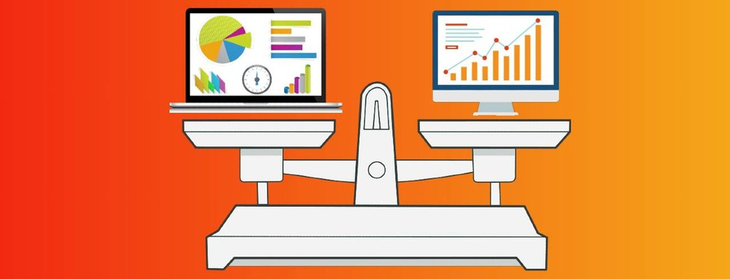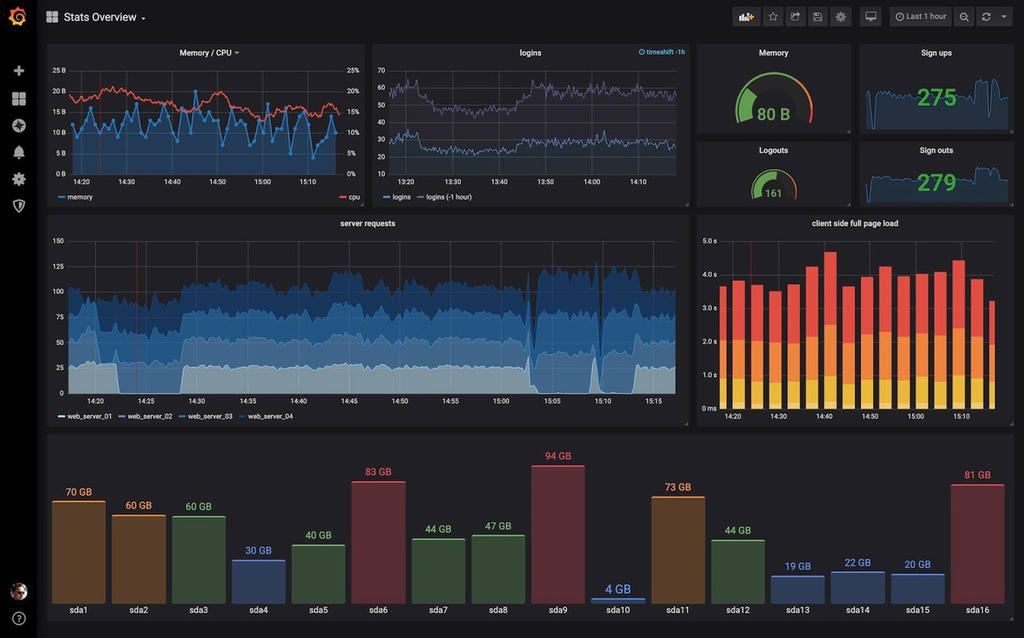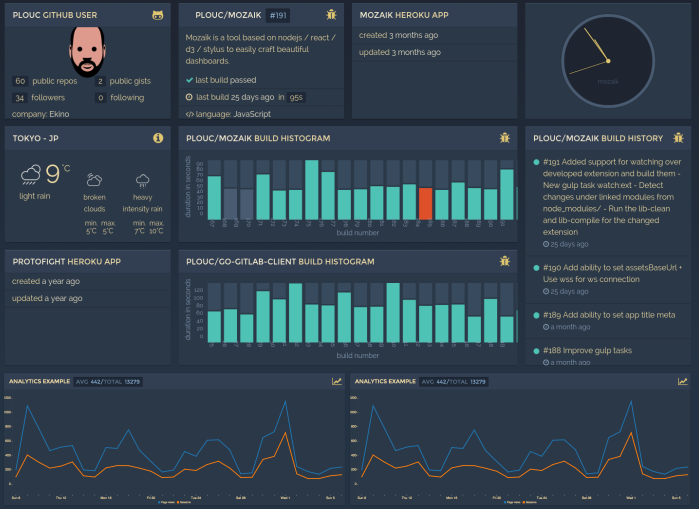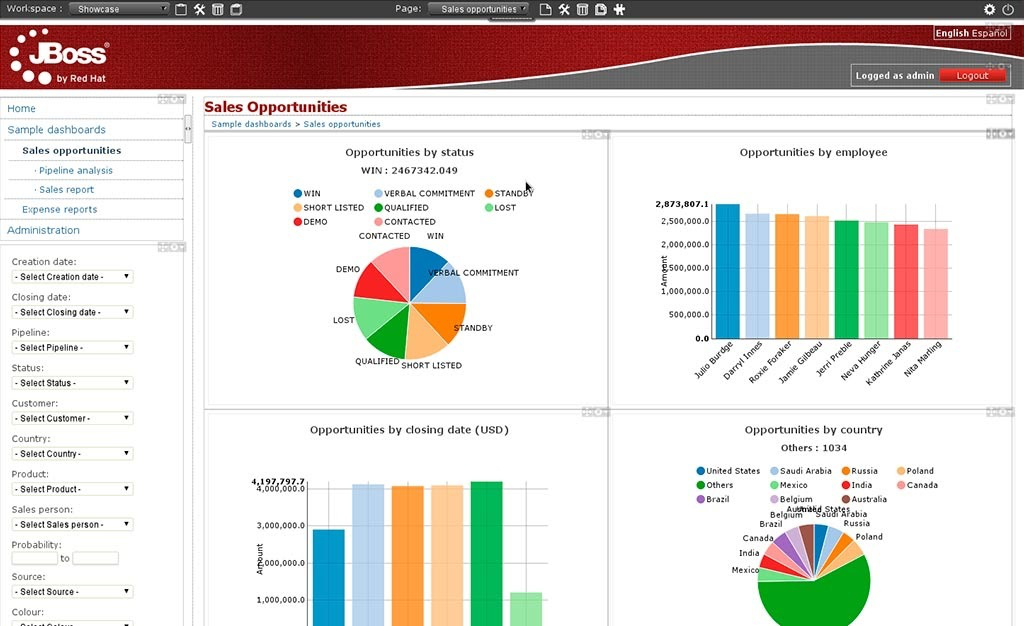Top 8 Open Source Dashboards

A dashboard is a data visualization and management tool that visually tracks and analyzes the Key Performance Indicators (KPIs), business analytics metrics, infrastructure health and status, and data points for an organization, team, or process.
Introduction
Before exploring open-source dashboard tools, we first need to learn about Dashboards and how they can be useful.
A dashboard is a data visualization and management tool that visually tracks and analyzes the Key Performance Indicators (KPIs), business analytics metrics, infrastructure health and status, and data points for an organization, team, or process. It can be used to present operational and analytical business data with interactive data visualizations to your team. Dashboards can aid the senior leaders, executives, and engineers to establish targets, analyze progress, monitor their infrastructure, and implement appropriate changes. Infrastructure monitoring with dashboards is critical to identify and record important metrics for systems in use. Be it physical, virtual or cloud, it also helps plan for up-gradation of outdated systems with minimum downtime or inconvenience to users and customers.
Now that we know a little more about dashboards, it's time to see what features we should look out for in a dashboard. You can also get right onto a MetricFire free trialand start comparing it with the others.
Finding the perfect Dashboard
Ease of Use
A dashboard tool should be easy to use and learn. It should have a simple interface to create and manage dashboards, that doesn’t require understanding of code.
Customization
Different users might need different sizes, arrangements, and types of tools on their dashboard. A dashboard tool must be easily customized to fit the requirements of the user.
Scalability
Every project and organization experiences growth with time. It is not efficient to keep changing the required tools after each phase of growth. A good tool needs to scale to match the growth of the project and it should provide tools that can accommodate the growth.
Integration
A good tool needs to be integrable with other tools and databases available in the market.
Extendable
The tool should be extendable to incorporate new requirements of a project. Extendability is created by allowing for plugins.
Modularity
Modularity allows different parts of the dashboard to function independently of each other, which makes the dashboard more efficient and easier to use. Compact modules help improve the overall aesthetics of the dashboard - making it look cleaner and less cluttered.
Security Management
If a user is using the dashboard to handle sensitive and private data, there should be enough security measures provided by the tool to make the data secure.
Exporting Options
Not all dashboard tools provide users the ability to export their data. Users who prefer to export their dashboard data to use it elsewhere should look out for the tools that allow data exporting and the supported formats.
Now that we know what we’re looking for, let’s start our voyage into the deep waters of dashboarding.
Grafana
Boasting one of the most active developer communities with over 900 active developers and 30k stars on Github, Grafana is a powerful, feature-rich data visualization tool that allows users to create, explore, and share dashboards. Written mostly in Go and Typescript, it is used primarily to monitor server/architecture health, but can also be used for different types of data visualization or metrics dashboards. It is useful for any business owner or individual looking for a visualization tool to analyze business metrics, but is most commonly used for infrastructure monitoring.
You can find out more about Grafana from their Website and on GitHub.
Pros
- It provides an official Library with a plethora of dashboard templates and plugins.
- It provides support for a large variety of data sources and databases, including Prometheus, Graphite, ElasticSearch, OpenTSDB, InfluxDB, and many more.
- It provides users with the ability to custom-tailor their desktop for any business.
- It provides built-in user control and authentication mechanism.
- It provides a diverse set of features, including snapshots, data annotations, and much more.
- It allows users customized alerting and notifications.
Cons
- Grafana is only a visualization tool and does not provide support for data collection or data storage.
- The dashboard requires a considerable amount of time to set up and is not as effective as a quick solution.
Freeboard
Let's start with a dashboard that boasts its simplicity and ease-of-use as its best features. Freeboard is a simple, open-source dashboard tool that allows users to create and customize real-time interactive dashboards. It is primarily designed to be used with IoT devices and is ideal for organizations and individuals working with web apps, external devices, or sensors. We really liked the easy to use drag and drop interface provided by Freeboard along with the free and paid hosted options for personal and team access to dashboards.
You can check out Freeboard at their Website or on GitHub.
Pros
- You can easily create data sources and add widgets to your dashboards.
- The dashboard runs as a single page static web page removing the need for a server.
- Easy integration with any web-based API you use.
- Licensed under MIT for users to utilize other Freeboards as a starting point for their own dashboards. We think this can be a pretty useful feature for beginners & professionals alike.
- Freeboard also provides you a production-ready dashboard as an easily shareable, unique URL. A feature we really liked.
- You get unlimited free dashboards that can be used on as many devices as you like.
Cons
- The free version does not provide support for private dashboards. We recommend the premium edition for handling sensitive data.
- A lack of data visualization capabilities in comparison to its competitors.
- Freeboard requires you to be familiar with the JavaScript ecosystem to create your plugins. But, it also provides an easy to follow plugin architecture at Plugin Example.
Mozaïk
Mozaïk is a highly customizable dashboard tool built on the JavaScript trifecta of Node, React, and D3 to create beautifully crafted dashboards. Dashboards which are designed to be easily scalable and extendable using modules, are compatible with multiple devices. We liked the simple, user-friendly interface and easily integrable widgets that Mozaïk provides.
You can learn more about Mozaïk at their Website and on GitHub.
Pros
- It provides users with the ability to create and use multiple dashboards.
- Optimized backend communications and real-time support using WebSockets.
- It provides a grid system to help users define their dashboard layout. A great feature that makes it easy for users to design their dashboards.
- It comes with 6 highly-customizable themes and allows users to create their own themes.
- It provides dashboards with a scalable layout that supports multiple devices.
- It provides a wide array of widgets that allow the dashboards to access a lot of services.
Cons
- Creating widgets that are not already available is a challenging task and requires a fair amount of coding know-how.
- A lack of data manipulation capabilities and advanced business metrics.
Dashbuilder
Next up is the dashboard tool made for non-technical users. Available under the Apache v2.0 License, Dashbuilder is a fully featured web app dashboard tool that allows users to create deployment-ready dashboards through a visual interface. It is a Java-based tool that creates highly customizable dashboards. The newer rewritten version, UF Dashbuilder, has more features and an even better user Interface. It's a great tool for business activity monitoring.
You can find out more about Dashbuilder from their Website and on GitHub.
Pros
- It supports a variety of visualization tools and libraries.
- It can be used to create static or real-time dashboards with relative ease.
- It can take data from a variety of data sources, including JDBC databases and text files.
- It provides support for the inline creation and editing of KPIs.
- It provides fine-tuned access control features for multiple users and roles.
- It provides data export capabilities to Excel and CSV formats.
Cons
- Dashbuilder lacks integration possibilities for existing REST/SOAP systems.
- A lack of customization and personalization capabilities for users.
Stashboard
Unlike the other dashboards, Stashboard was written originally to provide information regarding phones and communication APIs. Stashboard is a tool used to create dashboards providing status information about cloud services and APIs. It is a great tool, ideally for small to medium-sized businesses that use cloud services or API and need to track the status of these services.
Check out their Website and GitHub for more information about Stashboard.
Pros
- It is designed to run as an independent application using Google App Engine. So, it will display the service status even if the main service goes down.
- It provides full REST API for both getting and setting status information.
- It can track multiple APIs and SaaS services.
- It provides users with the ability to customize status messages and icons.
- It provides status history for every service which can be requested by the user at any time.
Cons
- It is limited in its application as it can only provide the status of different applications
Re: Dash
Re: Dash is an open-source dashboard tool that allows users to connect their data sources and visualize data on a single platform. It boasts a large collection of integrated databases, including PostgreSQL, MySQL, Google BigQuery, Graphite, ElasticSearch, MongoDB, Presto, InfluxDB, and many more.
You can learn more about Re: Dash at their Website and GitHub.
Pros
- Re: Dash is available both as a SaaS solution and an open-source self-hosted solution.
- It provides users with many useful features like social sharing, customizability, drag & drop, and many more.
- It provides powerful data visualization features to the user.
- It provides users with a platform to write effective queries for the supported data sources.
Cons
- It lacks some Business Intelligence and data exploration features.
- A considerable amount of time needs to be invested to properly learn how to use the dashboard.
Kibana
Representing the K in the world's leading log management platform, the ELK stack, Kibana is a powerful open-source data navigation and visualization application. It provides users the ability to monitor and manage their ElasticStack data. It is a great tool for anyone that desires to use Elasticsearch or the ELK stack to manage their data.
Find out more about Kibana and the ELK stack at their Website and GitHub.
Pros
- It allows users to create their own ways to represent their data and figures along with the standard visualization tools.
- It lets users explore the relationships in their data.
- It requires no additional coding or infrastructure as it runs on a Node.js web server.
- It provides powerful anomaly detection features to detect issues in the data easily.
- It provides users with data sharing capabilities, including some data export capabilities to PDF and CSV formats.
- It provides an efficient and easy to use single UI.
Cons
- The data exporting features are still limited.
- Since it works with ElasticStack, ElasticStack's limitations also affect Kibana.
Tipboard
Next is the tool ranked #1 by slant.co for the best open source dashboard framework. Written in JavaScript and Python, Tipboard is an open source dashboard tool used to create customizable and neat looking business metric dashboards. The Tipboard widgets are separate from its data sources, which make the dashboards flexible and highly customizable.
You can learn more about Tipboard from their Website and GitHub.
Pros
- Easy to configure and build dashboards using YAML.
- It is a self-hosted platform, so the user's data is safe.
- It allows users to create multiple dashboards in a single instance.
- It provides an HTTP API for pushing JSON data to the dashboard.
- It provides users with a library of widgets and the ability to create their own widgets.
Cons
- Tipboard is written in Python 2.7 and provides no Python 3 support.
Smashing
It’s time to meet the brother of one of the most beautiful dashboard tools, the now discontinued, Dashing. Dubbed the spiritual successor to Dashing by its developers, Smashing is a Sinatra based Dashboard tool that allows users to create aesthetically exceptional dashboards. Smashing provides users with comprehensive documentation, including a large variety of examples.
To learn more about Smashing, check out their Website and GitHub.
Pros
- It provides users with an enormous library of pre-made widgets and the ability to create their own widgets using HTML, SCSS, and CoffeeScript.
- It provides simple and easy to use deployment capabilities to Heroku.
- The widgets can be fed the required data directly using Ruby.
- It provides an easy to use drag & drop interface for arranging widgets and designing dashboards.
- It provides users with the ability to use their own authentication for their boards.
- It provides users with an HTTP API to push JSON data on the dashboard.
Cons
- Smashing does not provide support for or run in any version of Internet Explorer.
MetricFire
Metricfire is a premium infrastructure monitoring platform that provides cloud-based infrastructure and application monitoring capabilities using open source tools. It provides users with a plethora of business & infrastructure metrics using Hosted Prometheus or Graphite on beautifully crafted Grafana dashboards. Check out their Website to find out more about MetricFire. Get a free trial and start making MetricFire dashboards right away. Feel free to book a demo if you have questions about what MetricFire can do for you.
Pros
- It provides users with long term storage for their metrics and other related data.
- It provides great data security capabilities, including secure data transport over HTTPS connections.
- It allows users to create customizable alerts for actionable events in their metrics.
- It provides users with simple and easy to learn APIs to handle the monitoring.
- It provides users with sharing and access control capabilities.
- It provides a feature-rich, intuitive, easy to use UI for the users to easily create and manage their Grafana dashboards.
- It provides users with affordable plans according to the size of their teams and level of monitoring, including custom plans for enterprise users.
Cons
- MetricFire is a premium service and does not provide free to use options. But it provides a 14 day free trial for users who want to try the service before subscribing to the premium service.
Conclusion
We explored a large variety of dashboard tools in our journey; dashboards meant for different purposes, providing different features, handling different types of data, and suitable for different types of users. No dashboard is perfect for everyone. Each one has its pros and cons. Find out what features are more important to your work, and choose the desktop that suits you the most.
This article was co-written by Nikhil Maan, & Vipul Gupta.
Vipul Gupta and Nikhil Maan are open-source developers and writers at Mixster. Mixster is an initiative with an aim to write better content for the open web. Starting back in 2017, we have collaborated and worked with early-stage startups, major open-source organizations, and on projects just like with the amazing folks at MetricFire. Let’s connect!
Get similar stories in your inbox weekly, for free
Share this story:

MetricFire
MetricFire provides a complete infrastructure and application monitoring platform from a suite of open source monitoring tools. Depending on your setup, choose Hosted Prometheus or Graphite and view your metrics on beautiful Grafana dashboards in real-time.
Latest stories
HIPAA and PCI DSS Hosting for SMBs: How to Choose the Right Provider
HIPAA protects patient data; PCI DSS protects payment data. Many small and mid-sized businesses now …
The Rise of GPUOps: Where Infrastructure Meets Thermodynamics
GPUs used to be a line item. Now they're the heartbeat of modern infrastructure.
Top Bare-Metal Hosting Providers in the USA
In a cloud-first world, certain workloads still require full control over hardware. High-performance computing, latency-sensitive …
Top 8 Cloud GPU Providers for AI and Machine Learning
As AI and machine learning workloads grow in complexity and scale, the need for powerful, …
How ManageEngine Applications Manager Can Help Overcome Challenges In Kubernetes Monitoring
We tested ManageEngine Applications Manager to monitor different Kubernetes clusters. This post shares our review …
AIOps with Site24x7: Maximizing Efficiency at an Affordable Cost
In this post we'll dive deep into integrating AIOps in your business suing Site24x7 to …
A Review of Zoho ManageEngine
Zoho Corp., formerly known as AdventNet Inc., has established itself as a major player in …
Should I learn Java in 2023? A Practical Guide
Java is one of the most widely used programming languages in the world. It has …
The fastest way to ramp up on DevOps
You probably have been thinking of moving to DevOps or learning DevOps as a beginner. …
Why You Need a Blockchain Node Provider
In this article, we briefly cover the concept of blockchain nodes provider and explain why …
Top 5 Virtual desktop Provides in 2022
Here are the top 5 virtual desktop providers who offer a range of benefits such …





















